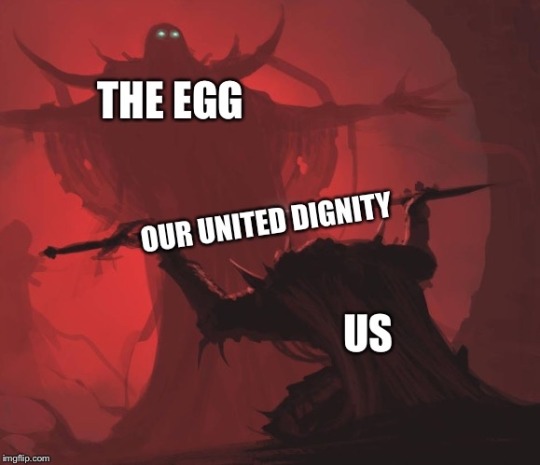#world_record_egg
Text
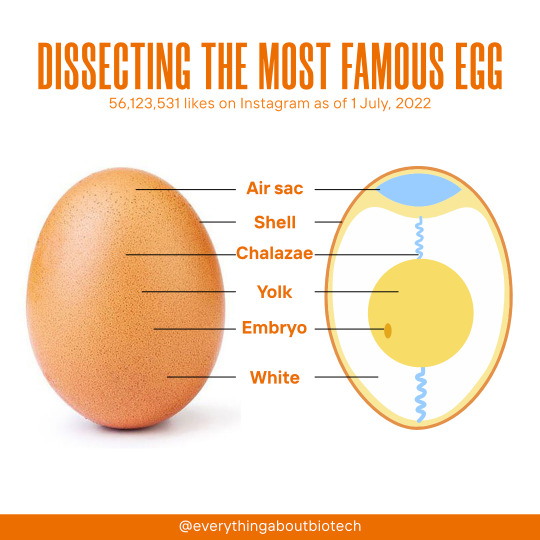
The most liked image on Instagram is a photo of an egg, achieved by the Instagram account "world_record_egg" posted by the Egg Gang, with 56,123,528 likes, as of 1 July 2022.
.
Dissecting The Most Famous Egg🥚
.
.
Share with your friends😊
╍╍╍╍╍╍╍
💎Here to HELP You:
✔️Graphical Abstract Design
✔️Journal Figures Design
✔️Scientific Illustration
✔️Flyer and Poster Design
✔️Infographic Design
✔️Slides Design
.
💎 | Follow @everythingaboutbiotech
.
🔔 | Turn on POST NOTIFICATION!!
#egg#egggang#most liked picture on instagram#famous egg#biotechnology#biotech#science#biology#biochemistry#studyblr#molecularbiology#notes#class notes#students#science illustration#illustration#illustragram#graphic art#scicomm#sciart
77 notes
·
View notes
Text
Foto de Messi com a taça da Copa é a mais curtida do Instagram após superar ovo
Foto de Messi com a taça da Copa é a mais curtida do Instagram após superar ovo
Com mais de 50 milhões de likes, o jogador argentino Lionel Messi quebrou recorde do Instagram
Lionel Messi continua quebrando recordes mesmo fora dos campos. O jogador argentino, vencedor da Copa do Mundo de 2022 no último domingo, 18, é o detentor da foto mais curtida da história do Instagram.
A marca anterior pertencia à foto de um ovo publicada em 2019 pela conta @world_record_egg. Como o…

View On WordPress
3 notes
·
View notes
Text
Messi heeft recordaantal likes met zijn Instagram-post en verslaat daarmee het mysterieuze ei
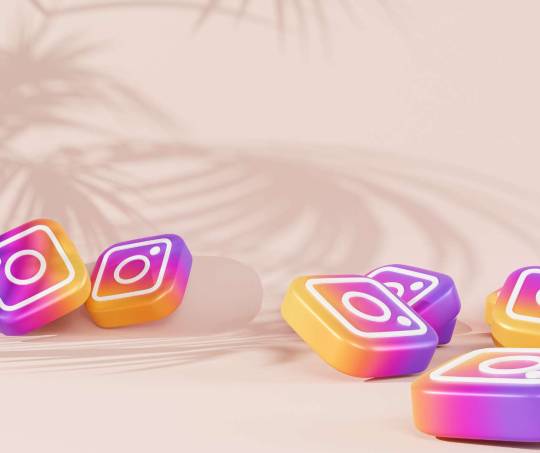
De Instagram-post van Lionel Messi met foto’s van de WK-winst van Argentinië heeft met momenteel ruim 69 miljoen likes de foto van een mysterieus ei verslagen, die bijna 58 miljoen likes kreeg, als post met de meeste likes ooit. Op die foto’s is te zien hoe Messi en zijn Argentijnse ploeggenoten feestvieren vanwege het winnen van het WK Voetbal 2022 in Qatar. Deze werden 2 dagen geleden gepost door Messi, die ook tot beste speler van het WK 2022 werd uitgeroepen en de gouden bal kreeg uitgereikt.
Voordat Messi dit recordaantal likes vestigde, ging die eer dus naar de eerste foto van world_record_egg. In 2019 werd die foto van het ei gepost, waarbij er werd opgeroepen hiermee het recordaantal likes te breken. Er werd destijds dagenlang gespeculeerd over degene die de foto had geplaatst, dat uiteindelijk een 29-jarige Brit bleek te zijn die in de reclamewereld werkte. Voor de foto van dit ei was de eerste foto van de dochter van realityster Kylie Jenner, Stormi Webster, de foto met het toen nog recordaantal likes van 18 miljoen.
Read the full article
0 notes
Text
Lionel Messi's World Cup Win Instagram Post Sets A New World Record, It Surpasses This Post
Lionel Messi’s World Cup Win Instagram Post Sets A New World Record, It Surpasses This Post
Lionel Messi is still breaking records, two days after he guided Argentina to their third FIFA World Cup title with a win over France in the final at the Lusail Stadium in Doha. His Instagram post after the World Cup win, titled – “CHAMPIONS OF THE WORLD!!!!!!!”, has now got over 56 million likes. It is the most liked post on Instagram. Messi’s post broke the record of “World_record_egg” which…
View On WordPress
#argentina#cristiano ronaldo dos santos aveiro#fifa world cup 2022#football ndtv sports#france#lionel andres messi cuccittini
0 notes
Text
TOP 5 de publicaciones con más likes de Instagram
TOP 5 de publicaciones con más likes de Instagram
El huevo de Instagram cautivó a todo el mundo, pero hace solo unos días lo han superado. Por eso dejo aquí el TOP 5 de publicaciones con más likes de Instagram (por lo menos hasta la fecha). Fuente: EL PAÍS.
Estas son las 5 o como realmente “es”, el TOP 5:
Messi levantando la copa del mundo, por @leomessi
El huevo, por @world_record_egg
Cristiano y Messi “juegan” al ajedrez, por…

View On WordPress
0 notes
Text
Lionel Messi's World Cup Win Instagram Post Sets A New World Record, It Surpasses This Post
Lionel Messi’s World Cup Win Instagram Post Sets A New World Record, It Surpasses This Post
Lionel Messi is still breaking records, two days after he guided Argentina to their third FIFA World Cup title with a win over France in the final at the Lusail Stadium in Doha. His Instagram post after the World Cup win, titled – “CHAMPIONS OF THE WORLD!!!!!!!”, has now got over 56 million likes. It is the most liked post on Instagram. Messi’s post broke the record of “World_record_egg” which…

View On WordPress
1 note
·
View note
Photo

Where? #notice #edit #photography #photoshop #actor #ayush_arpan #likeforlikes #liketheegg #egggang #eggsoldiers @world_record_egg @beatking_sumedh @cristiano (at Berhampore, India) https://www.instagram.com/p/CkDOqxSu4QC/?igshid=NGJjMDIxMWI=
1 note
·
View note
Text
Most Liked Instagram Posts of All Time

Being noticed in Instagram is more than excellent content. You must be aware of the timing of your posts, engage with your audience and be in the pulse recent trends.
The most popular content on Instagram are typically created by famous people who are not just adept at these techniques however, they also have an engaged fan base.
If you're looking to gain knowledge from the experts if you're looking to learn from the pros, then you're in the right spot. In the blog, we'll break down the most popular Instagram posts ever.
We'll also provide some advice https://comprarseguidoresargentina.com/ for getting more fans and followers for one’s own posts on Instagram.
Let's get started!
How to See Someone's Most Liked Instagram Post
Contrary to what many believe the truth is that likes and followers aren't the only thing that matter. For those who are an influencer, or an established company on Instagram It's essential to determine what content is attracting the most interest from your followers.
It all begins by determining which posts have the most followers.
If you're trying to locate the most popular Instagram posting, then you'll have to install a third-party application similar to the Popsters.
Popsters allows you to see some of the top posts on any publicly accessible Instagram account which includes your personal account.
For a start, input an account name of the user who's posts you wish to view. Popsters will show you the most popular Instagram post and the number of views the post received.
It will also show the number of views and comments for each post.
It can be time-consuming and exhausting however, you might find some inspiration in the process.
#1: Most Liked Instagram Post of All Time: Photo of an Egg
The most popular Instagram post ever, according to Statista it can be described as "photo of an egg" from @world_record_egg.
Yes, this post in 2018 was liked 55.7 millions of times. The world record egg set the goal to beat Kylie Jenner's first Instagram record (18 million likes for a single image) and they succeeded!
Congratulations to the entire egg team! You've done it.
#2: Ronaldo Announces Twins
The second spot on the top rated Instagram list of posts follows Cristiano Ronaldo's double announcement to his the wife Georgina Rodriguez.
The picture depicts Ronaldo and Rodriguez lying on their bedwith a photograph of an ultrasound that shows two babies growing.
Ronaldo's blog post is: "Delighted to announce we are expecting twins. Our hearts are filled with affection - we cannot wait to meet you"
#3: LOVE IS WAR
The late rapper XXXTentacion gets the third position among the most liked Instagram posts ever. Before his passing, XXX posted a sepia-toned image of himself upside down with the caption "LOVE IS WAR".
The fans of the rapper can still see his post via his Instagram account as the only and final picture left by his account.
List of the 20 Most Liked Instagram Posts of All Time
Are you looking for a comprehensive list of the top-rated Instagram posts ever? You're in the right place! We've collected the top 20 most popular Instagram posts to let you see the ones that were included in the top 20.
Certain content, such as images from the Billie Eilish's account and Cristiano Ronaldo's account, rank twice as the most popular Instagram posts for 2021.
Check the complete list here:
Rank
Post Description
Posted By
Number of Likes
1.
Photo of an Egg
@world_record_egg
55.9 Million
2.
Ronaldo announces twins
@cristiano @georginagio
32.8 Million
3.
XXXTentacion's last Instagram post
@xxxtentacion
28.4 Million
4.
Wedding photos of Ariana.
@arianagrande
22.9 Million
5.
Kylie Jenner announces 2nd baby
@kyliejenner
24.9 Million
6.
Three generations of Spiderman
@tomholland2013
23.3 Million
7.
Kylie Jenner new baby
@kyliejenner
22.9 Million
8.
Billie Eilish blonde hair
@billieeilish
22.9 Million
9.
Messi signs PSG
@leomessi
22 Million
10.
Billie Elish Vogue photoshoot
@billieeilish
21.9 Million
11.
Photo of Copa America trophy
@leomessi
21.9 Million
12.
Messi departs Barcelona
@leomessi
21.1 Million
13.
Tom wishes Zendaya a happy birthday. Zendaya
@tomholland2013
20.3 Million
14.
Khaby Lame in Brazil shirt
@khaby00
20.1 Million
15.
Mermaid Montana and a little girl
@ironshoremermaid
20 Million
16.
Ronaldo with his son
@cristiano
20 Million
17.
Ronaldo remembers Diego Maradona
@cristiano
19.7 Million
18.
V's dog Yeontan
@thv
19.4 Million
19.
Billie at Met Gala 2021
@billieeilish
19.3 Million
20.
Ronaldo 2nd debut Manchester United
@cristiano
19.3 Million
How to Get More Likes on Instagram?
Instagram is about creating connections with your followers. To achieve this, you must be authentic and creative. Also, you should provide helpful tips via videos and photos.
When you've got a solid knowledge of what your customers are searching for you can then start creating content that will appeal to them.
When you share captivating and interesting content, Click here you'll quickly get more likes.
Remember, in order to get likes, you'll require followers. Don't put off building an organic following! Get started by purchasing followers from https://comprarseguidoresargentina.com/ .
The purchase of followers can help get started on the process of establishing your Instagram account and help get it moving. It can also provide you with a an increase in confidence being aware that people are keen to hear the content you post. You may also purchase likes to your blog and more.
If you're looking to get more likes for your posts try these suggestions:
Utilize hashtags Hashtags can be a fantastic way to get your content in front of new audiences. When you use hashtags that are relevant to your content your content will be more likely to appear on search results.
Post during high-traffic time: The ideal timing to upload content Instagram occurs between the hours of 1 p.m. between 1 and 2 p.m. (EST). The majority of people is taking their lunch break, and is looking for something to distract them.
Join and collaborate with others: Take the time to follow and like others' posts. It's not just an excellent manner of conduct however; you're more likely to be noticed.
Utilize creative images: Spend some time editing your photos prior to when you upload them. A bit of work can make a huge difference to make your photos appear more professional.
Do not fake it: A majority of users are on social media in order to meet new people and to enjoy themselves, which is why it's crucial that you are authentic in what posting. People don't want to follow someone who appears fake, so make sure you're yourself!
#Comprar Seguidores Instagram Argentina#Marketing do Instagram#Comprar Seguidores no Instagram#Marketing de Mídia Social
0 notes
Text

Illustration by Nicholas Konrad/The New Yorker
Infinite Scroll: How the Internet Turned Us Into Content Machines
Two new books examine how social media traps users in a brutal race to the bottom.
— By Kyle Chayka | June 4, 2022 | The New Yorker
In the beginning, there was the egg. In January of 2019, an Instagram account called @world_record_egg posted a stock photo of a plain brown chicken egg and launched a campaign to get the photo more likes than any online image had before. The record holder at the time was an Instagram shot of Kylie Jenner’s daughter, Stormi, which had more than eighteen million likes. In ten days, the egg’s like count rocketed beyond thirty million. It remains at the top of the chart to this day, with more than fifty-five million. The account’s creators, who came from the advertising industry, later teamed up with Hulu for a mental-health P.S.A. in which the egg “cracked” owing to the pressures of social media. The egg’s arc was the epitome of a certain kind of contemporary Internet success: gather a big enough audience around something—anything—and you can sell it off to someone.
For Kate Eichhorn, a media historian and a professor at the New School, the Instagram egg is representative of what we call “content,” a ubiquitous yet difficult-to-define word. Content is digital material that “may circulate solely for the purpose of circulating,” Eichhorn writes in her new book, “Content,” which is part of M.I.T. Press’s “Essential Knowledge” series of pithy monographs. In other words, such content is vapid by design, the better to travel across digital spaces. “Genre, medium, and format are secondary concerns and, in some instances, they seem to disappear entirely.” One piece of intellectual property inspires a feeding frenzy of podcast, documentary, and miniseries offshoots. Single episodes of streaming-service TV can run as long as a movie. Visual artists’ paintings appear on social media alongside their influencer-style vacation photos. All are part of what Eichhorn calls the “content industry,” which has grown to encompass just about everything we consume online. Evoking the overwhelming flood of text, audio, and video that fills our feeds, Eichhorn writes, “Content is part of a single and indistinguishable flow.”
Over the past decade, a number of books have tried to take stock of how the Internet is influencing us, and what we should do about it. Eli Pariser’s “The Filter Bubble,” from 2011, demonstrated, early on, the homogenizing effects of digital feeds. After Facebook and its ilk became much more mainstream, the pioneering technologist Jaron Lanier wrote a book called “Ten Arguments for Deleting Your Social Media Accounts Right Now” (2018). Shoshana Zuboff’s book, “The Age of Surveillance Capitalism,” published in the U.S. in 2019, diagrammed the systemic problems of mass data absorption. Eichhorn’s is one of a new crop of books that focus their attention on the user experience more directly, diagnosing the increasingly dysfunctional relationship between lone individual and virtual crowd.
Once upon a time, the Internet was predicated on user-generated content. The hope was that ordinary people would take advantage of the Web’s low barrier for publishing to post great things, motivated simply by the joy of open communication. We know now that it didn’t quite pan out that way. User-generated GeoCities pages or blogs gave way to monetized content. Google made the Internet more easily searchable, but, in the early two-thousands, it also began selling ads and allowed other Web sites to easily incorporate its advertising modules. That business model is still what most of the Internet relies on today. Revenue comes not necessarily from the value of content itself but from its ability to attract attention, to get eyeballs on ads, which are most often bought and sold through corporations like Google and Facebook. The rise of social networks in the twenty-tens made this model only more dominant. Our digital posting became concentrated on a few all-encompassing platforms, which relied increasingly on algorithmic feeds. The result for users was more exposure but a loss of agency. We generated content for free, and then Facebook mined it for profit.
“Clickbait” has long been the term for misleading, shallow online articles that exist only to sell ads. But on today’s Internet the term could describe content across every field, from the unmarked ads on an influencer’s Instagram page to pseudonymous pop music designed to game the Spotify algorithm. Eichhorn uses the potent term “content capital”—a riff on Pierre Bourdieu’s “cultural capital”—to describe the way in which a fluency in posting online can determine the success, or even the existence, of an artist’s work. Where “cultural capital” describes how particular tastes and reference points confer status, “content capital” connotes an aptitude for creating the kind of ancillary content that the Internet feeds upon. Since so much audience attention is funnelled through social media, the most direct path to success is to cultivate a large digital following. “Cultural producers who, in the past, may have focused on writing books or producing films or making art must now also spend considerable time producing (or paying someone else to produce) content about themselves and their work,” Eichhorn writes. Pop stars log their daily routines on TikTok. Journalists spout banal opinions on Twitter. The best-selling Instapoet Rupi Kaur posts reels and photos of her typewritten poems. All are trapped by the daily pressure to produce ancillary content—memes, selfies, shitposts—to fill an endless void.
The dynamics Eichhorn describes will be familiar to anyone who uses social media with any regularity. She doesn’t break ground in our understanding of the Internet so much as clarify, in eloquently blunt terms, how it has created a brutal race to the bottom. We know that what we post and consume on social media feels increasingly empty, and yet we are powerless to stop it. Perhaps if we had better language for the problem, it would be easier to solve. “Content begets content,” Eichhorn writes. As with the Instagram egg, the best way to accrue more content capital is to already have it.
Eichhorn’s sense of a path forward is unclear. She briefly notes the idea of “content resisters,” who might consume vinyl records and photocopied zines instead of Spotify and Instagram. But such solutions seem quaint, given the degree to which the Internet is embedded in our daily lives and experiences. Like so many technologies that came before, it seems to be here to stay; the question is not how to escape it but how to understand ourselves in its inescapable wake. In his new book, “The Internet Is Not What You Think It Is,” Justin E. H. Smith, a professor of philosophy at the Université Paris Cité, argues that “the present situation is intolerable, but there is also no going back.” Too much of human experience has been flattened into a single “technological portal,” Smith writes. “The more you use the Internet, the more your individuality warps into a brand, and your subjectivity transforms into an algorithmically plottable vector of activity.”
According to Smith, the Internet actually limits attention, in the sense of a deep aesthetic experience that changes the person who is engaging. The business model of digital advertising incentivizes only brief, shallow interactions—the gaze of a consumer primed to absorb a logo or brand name and not much else. Our feeds are designed to “prod the would-be attender ever onward from one monetizable object to the next,” he writes. This has had a deadening effect on all kinds of culture, from Marvel blockbusters that optimize for attention minute to minute, to automated Spotify recommendations that push one similar song after another. Cultural products and consumer habits alike increasingly conform to the structures of digital spaces.
“The Internet Is Not What You Think It Is” begins as a negative critique of online life, particularly as seen from the perspective of academia, an industry that is one of its disrupted victims. But the book’s second half progresses into deeper philosophical inquiries. Rather than a tool, the Internet might best be seen as a “living system,” Smith writes. It is the fulfillment of a centuries-old human aspiration toward interconnectivity—albeit a disappointing one. Smith recounts the story of the Frenchman Jules Allix, who, in the mid-nineteenth century, popularized a kind of organic Internet made out of snails. Perhaps drawing upon the physician Franz Mesmer’s theory of “animal magnetism,” which postulated the existence of a universal magnetic force connecting living things, it was predicated upon the idea that any two snails that had copulated remained linked across great distances. The technology—a telegraph-like device that used snails to purportedly send messages—was a failure, but the dream of instantaneous, wireless communication remained until humanity achieved it, perhaps to our own detriment.
Smith hunts for the most effective metaphor for the Internet, a concept that encompasses more than the vacuity of “content” and the addictiveness of the “attention economy.” Is it like a postcoital-snail telegraph? Or like a Renaissance-era wheel device that allowed readers to browse multiple books at once? Or perhaps like a loom that weaves together souls? He doesn’t quite land on an answer, though he ends by recognizing that the interface of the Internet, and the keyboard that gives him access to it, is less an external device than an extension of his questing mind. To understand the networked self, we must first understand the self, which is a ceaseless endeavor. The ultimate problem of the Internet might stem not from the discrete technology but from the Frankensteinian way in which humanity’s invention has exceeded our own capacities. In a sense, the Instagram egg has yet to fully hatch.
0 notes
Text
Comment Internet a fait de nous des machines à contenu
Comment Internet a fait de nous des machines à contenu
Au début, il y avait l’œuf. En janvier 2019, un compte Instagram appelé @world_record_egg a publié une photo d’un œuf de poule brun nature et a lancé une campagne pour obtenir la photo plus de likes que n’importe quelle image en ligne auparavant. Le détenteur du record à l’époque était une photo Instagram de la fille de Kylie Jenner, Stormi, qui comptait plus de dix-huit millions de likes. En dix…

View On WordPress
0 notes
Text
World record egg!???!!
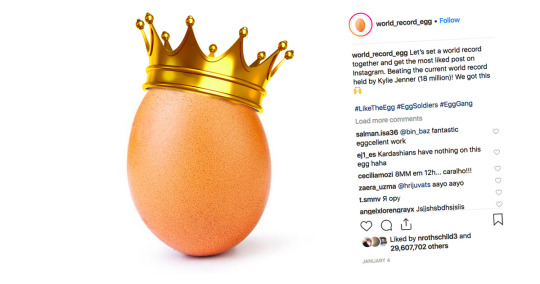
Я понимаю, что прошло уже довольно много времени с тех пор, как в сети появилось некое загадочное «яйцо», набравшее на данный момент свыше 53 млн лайков в социальной сети инстаграм. Цель того поста была побить мировой рекорд лайков, который тогда принадлежал Кайли Дженнер. И я вот думаю: или мы все сходим с ума или я что-то в этой жизни не понимаю. Почему мировой славы не добиваются люди думающие,трудящиеся,талантливые??
Тысячи великолепнейших художников сидят на улицах, непризнанные обществом, а в музеях продолжают красоваться картины Малевича. Но здесь давайте будем честны друг перед другом: бОльшее количество людей знают у него лишь 1 картину, а если знают больше, то первое, что придёт им на ум- это обязательно будет небезызвестный «Чёрный квадрат». Впрочем, это уже о высоком, об искусстве… А теперь вернёмся к тому, с чего начали. Заглянув в отметки «лайкнувших», я увидела там около 100 моих знакомых, подписчиков и людей, на которых была подписана и я. Стадное чувство? Цепная реакция? Если бы я также лайкнула данный пост, было бы слишком ожидаемо. Но так как искренне не понимаю, откуда в самом начале начало расти количество аккаунтов, ставивших отметку «нравится» на это фото, я решила, что без моего лайка там хватает любителей оригинальности.
Нашумевшая история. И вот я сама, не понимая, как говорится, прикола, сейчас сижу и пишу про то, что внимания по идее не должно было и заслужить, но в итоге заслужило.
Думаю, у многих сейчас возникает вопрос в голове: Что бы такое написать или сделать, чтобы наконец получить должное внимание и славу??
#world_record_egg#EggGang#TalkingEgg#русский tumblr#русский блог#русский текст#русский пост#русский тамблер#текст#текстовый блог#текстовый пост#текстовый тамблер#слава#известность#инстаграм#мысли#мысли вслух
6 notes
·
View notes
Photo
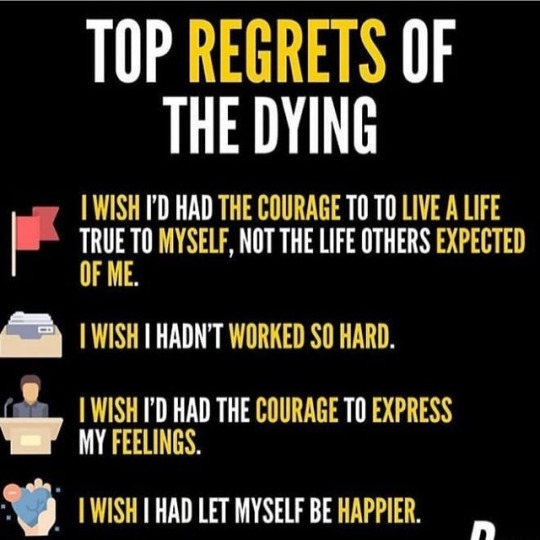
Don't regret during your last time.please read it carefully.. #businessowner #business #billionaireboysclub #entrepreneur#billionaire #worldrecordegg #world_record_egg #egg https://www.instagram.com/p/BsnIswiHEg6/?utm_source=ig_tumblr_share&igshid=1rtb09khtfqha
#businessowner#business#billionaireboysclub#entrepreneur#billionaire#worldrecordegg#world_record_egg#egg
5 notes
·
View notes
Text
Dudes
Go like the post of @ world_record_egg on Insta. They're trying to break a record and it's so funny haha
Lots of love
2 notes
·
View notes
Photo

🌠✨I am not a Alcoholic...✨ 🌠 #johnniewalker #johnniewalkerblue #johnniewalkerblack #johnniewalkerbluelabel #johnniewalkerthejourney #doubleblack #johnniewalkerdobleblack #drink #sad #painting #workstress #world_record_egg #kyliejenner #peg #alcholicsanonymous #paintings #instagram #instatrend #trending #happysunday #sundayfunday #sunday #evening #black #iam (at U.S. Consulate General Chennai) https://www.instagram.com/p/B-CQJFZHbcn/?igshid=17z957qxulyqi
#johnniewalker#johnniewalkerblue#johnniewalkerblack#johnniewalkerbluelabel#johnniewalkerthejourney#doubleblack#johnniewalkerdobleblack#drink#sad#painting#workstress#world_record_egg#kyliejenner#peg#alcholicsanonymous#paintings#instagram#instatrend#trending#happysunday#sundayfunday#sunday#evening#black#iam
0 notes
Text
Narrating Personal Interest
Influence equals power and power equals money.
The topic of influencers interests me for many reasons. As a millennial, I can relate and understand the appeal of becoming a social media influencer.
I applaud the entrepreneurial ambition and creativity that goes into making shareable content online – even the absurd. The size of online audiences grows every day as more people join the Internet and therefore, we've only seen the tip of the iceberg regarding the influencer economy.
If you told me two years ago that a picture of an egg would be the most 'liked' post on Instagram, well I wouldn't have believed you. But 53 million likes later and here we are. Social networking sites are no longer just a fad amongst the youth. A report released in March this year confirmed that Instagram alone is a 1.7 billion dollar industry.

A lot has changed though since your teenager created their Instagram account back in 2009. I am fascinated by the growing power that social media holds in our society. I first began looking at influencers when I joined social media channels. Actually, as a matter of fact, I got a Facebook notification a few days ago celebrating my 12-year Facebook anniversary. Social media influencers have evolved since a decade ago, with more niche communities, larger audiences and now that profitability is existent. Digital monetisation has changed the game for social media influencers, as more users are being solely drawn in for financial gain which tends to result in higher amounts of inauthentic content.
Today, basically anyone can be an influencer as the barrier of entry is so low. It’s never been easier to create online content, to grow an audience following and to earn dollar bills. The age-old line, ‘I could do that’ perfectly describes the acceptance of the influencer movement. I would first like to showcase @justaconstructionguy, who as of this post has just over 500k followers on Instagram. A handful more than the 75 followers he had four months ago.
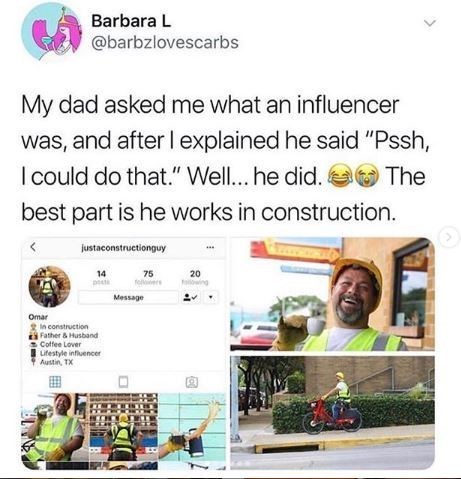
Social media influencers can grow an online presence in a short timeframe and gain a widespread following on platforms like Instagram. They are renowned for uploading #sponsored content and can earn up to $1,000 per 100,000 followers. I don’t know about you but that’s a pretty significant economical shift from a decade ago.
Finally, as the name of the blog suggests, I am interested in the authenticity of influencers and their viable longevity. Especially since Instagram (and now Facebook) recently announced plans to hide 'like' counts on posts in efforts to combat the rising concerns around the mental health of young people.
0 notes
